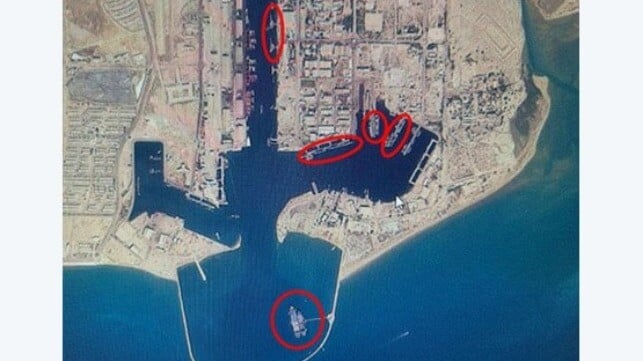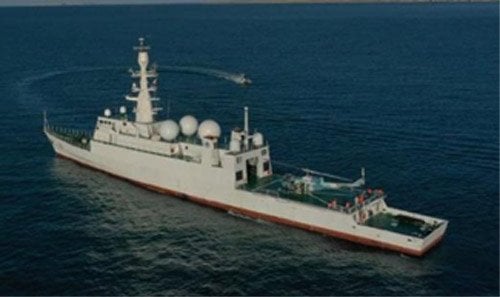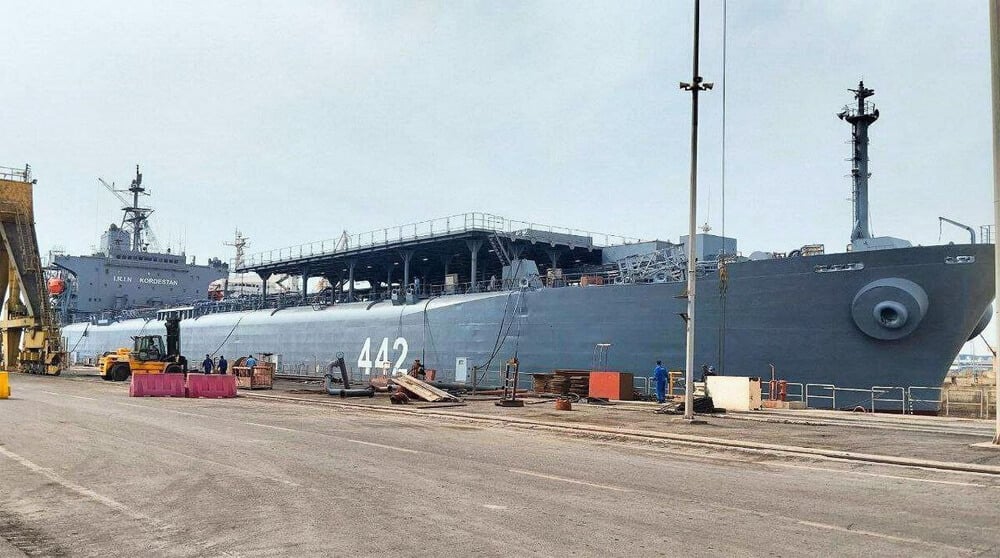Iranian Navy Loitering in Bandar Abbas Harbor

On a visit earlier this month to the headquarters of the IRGC Navy's 2nd Naval District in Bushehr, Deputy Chief of the Armed Forces Brigadier General Ahmad Vahidi stated that the presence of Iranian naval forces on Iran's maritime borders “instills such fear in enemies that they do not even dare to look sideways at these waters and lands.” During his visit, Brigadier Vahidi inspected some speedboats and a gallery of IRGC Navy martyrs who have fallen on operations this year.
However, satellite imagery of Bandar Abbas Naval Harbor, taken on November 21, shows that most of the principal ships of the Regular Iranian Navy (Nedaja) are tied up in the harbor. All five of the Nedaja’s five operational Alvand and Moudge Class frigates are on dockside berths, as well as the intelligence collection frigate IRINS Zagros (H313).

IRINS Zagros (IRNA/Iranian Navy)
Both long-range fleet resupply ships vessel IRINS Makran (K441) and IRINS Kurdestan (K442), are on their permanent pier in the outer basin. Two of the larger logistics vessels often used to support Nedaja deployments, for example to the Red Sea and Gulf of Aden, namely the Hengam Class landing ships (IRINS Tonb (L513) and Lavan (L514) are alongside, with a third vessel of the class, IRINS Larak (L512), still under refurbishment in the floating dry dock close by. Unfortunately, the imagery available is not of sufficient resolution to determine how many of the Nedaja's submarines are in the harbor.

IRINS Kurdestan (K442)(@mhmiranusa)
Since the 12-Day War, the Nedaja has, like this morning, been largely tied up in Bandar Abbas. The permanent presence in the Red Sea and Gulf of Aden, maintained since 2008, has been allowed to lapse, and Maritime Executive has not seen evidence of naval deployments into international waters for many months. With the exception of a small-scale drone and missile firing in August this year, as part of Exercise Sustainable Power 1404, exercise activity has appeared to have ceased, and it remains to be seen if Exercise Maritime Security Belt, the annual joint exercise with Russia and China, takes place during its regular slot in March every year. At a bare minimum, one might expect to see the long-range two-ship training cruise for naval cadets set out, which normally takes place in February.
Such an extended period of inactivity is likely to affect the operational training standards and perhaps sap the morale of the Nedaja commanders and sailors. The inactivity could indeed be a consequence of poor morale within the fleet.
????New from Iran ????
— National Union for Democracy in Iran (@NUFDIran) November 12, 2025
In a remarkable act of defiance against Ali Khamenei and the Islamic regime, two uniformed soldiers in the Iranian army have raised the pre-revolutionary Lion and Sun flag in the middle of one of Tehran's major metro stations. pic.twitter.com/b7E0AbId8s
In two unusual recent incidents, uniformed members of Iran's regular armed forces have made public demonstrations against the current regime in Iran, displaying the national flag of Iran as it was before the Islamic Revolution in 1979. One of these demonstrations took place at a Tehran metro station, with a colonel and lieutenant in uniform seen being arrested within 5 minutes of unfurling a pre-1979 flag on the station platform. IRGC Basij internal security forces were also seen rehearsing riot drills in Mashhad on November 15, as authorities prepare for possible internal disturbances likely in the wake of general unrest and nationwide shortages of water in particular.
Iran's President Masoud Pezeshkian's warning that in two weeks Tehran would run out of water has since passed without any rainfall to alleviate the situation, and the President is now saying that moving the capital is essential. On top of shortages of drinking water, the drop in the water table is threatening land subsidence in Tehran - in an area where buildings are already vulnerable to earthquake damage. Without indicating that any finance is available to fulfil such a plan, officials say the intention is to move the capital to the port city of Chah Bahar on the Indian Ocean.
